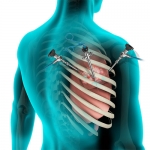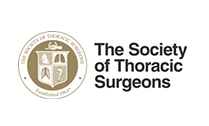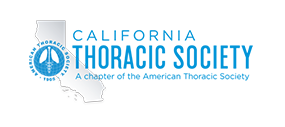By : Samer Kanaan, MD, FACS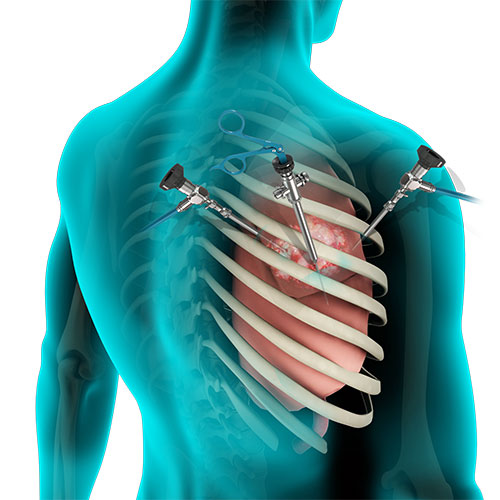
Lung cancer kills almost 160,000 Americans a year, and is the leading cause of cancer death for both men and women. In fact, more people die of Lung cancer than of, Breast, and Prostate cancers COMBINED!
The majority of patients with lung cancer present with advanced disease, but recent studies have shown a significant survival benefit with CT scan screening for former smokers. Lung cancer screening should lead to earlier detection and thus earlier stage lung cancers. Surgery is the treatment of choice for early lung cancer and offers the best chance for cure from lung cancer.
Lobectomy is the removal of a lobe of the lung, usually done to treat lung cancer. Traditionally, a thoracotomy was used to accomplish this, but the incision was large, and painful since this involved cutting or removing the ribs to access the thoracic cavity to perform surgery. Patients would require substantial recovery time both in and out of the hospital, and the traditional thoracotomy approach led to many postsurgical complications.
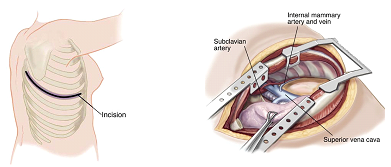
(Left) Traditional Thoracotomy Approach with large incision and removal of the rib and significant rib spreading..
Minimally invasive approaches have revolutionized the way thoracic surgeons approach lung cancer.
Minimally invasive thoracic surgery can be performed using video assistance or robotic assistance
- Video-assisted thoracic surgery (VATS)
Video-assisted Thoracic Surgery or VATS is a surgical technique that involves insertion of a thorascope; a long, thin tube with a camera attached on the end, through a small chest incision called a port. The thorascope allows the surgeon to visualize inside the chest cavity and to perform surgery using small surgical instruments inserted through one or two additional ports. For more extensive operations such as lung resection for cancer, an additional incision measuring about 6-8 centimeters is made for the removal of the lung tissue. - Robotic thoracic surgery
Robotic thoracic surgery is an even newer surgical approach which greatly enhances the surgeon’s visualization of the operative field, precision, and control compared to the traditional “open” surgery approach. With robotic thoracic surgery, the surgeon makes small 1 cm incisions in the same rib space to perform, for example, a lobectomy, without spreading or cutting the breastbone or ribs, thereby minimizing blood loss, pain and scarring. The surgeon controls the robot's movements from a nearby console in the operating room. The robot is equipped with high definition, 3D imaging capabilities enabling surgeons to perform thoracic surgery through small 1-2 cm incisions.
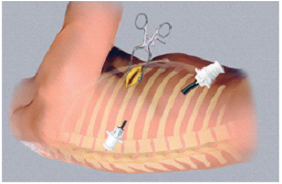
(Above) Minimally Invasive VATS Approach with small utility incision and thorascopic ports.
Conclusion
In conclusion, minimally invasive approaches such as VATS and Robotic surgery have greatly enhanced the ability of Thoracic Surgeons in treating Lung cancer, and should be viewed as the new gold standard of care.
BENEFITS OF MINIMALLY INVASIVE APPROACH
- Enhanced visualization
- Decreased trauma to the tissue
- Decreased postoperative pain
- Decreased postoperative respiratory and other complications
- Decreased Hospital Stay
- Shortened Recovery time, allowing return to work and daily activities sooner
- Ability to offer surgery to higher risk patients who would not be candidates otherwise
The advantages of minimally invasive surgery include smaller incision, no rib spreading or cutting, less pain, less pneumonia (3% vs 19% in open lobectomy), less atrial fibrillation (3% vs 20% in open lobectomy), shorter hospital stay (4 days vs 9 days in open lobectomy), and earlier return to normal activity and work.
Also, the minimally invasive technique allows thoracic surgeons to offer surgery to higher risk patients who would otherwise not be candidates for traditional surgery.
For more information, contact:
About the Author
Samer Kanaan, MD, FACS
Samer Kanaan, MD, FACS is a Harvard Fellowship trained thoracic surgeon specializing in operative, perioperative and critical care to patients with pathological conditions of the lungs, esophagus, chest wall, diaphragm, and mediastinum. He offers his patients minimally invasive surgical options that can significantly improve outcomes, including less pain and faster recovery.
He earned his Bachelor’s Degree at Northwestern University, and received his Medical Degree at Northwestern University Medical School. Dr. Kanaan completed his General Surgery Residency at Northwestern University, performed lung transplant research at Washington University, St. Louis and completed his Cardiothoracic Surgery Fellowship at the University of Southern California. He then completed a Fellowship in Thoracic Oncology and Minimally Invasive Thoracic Surgery at the Brigham and Women’s Hospital in Boston.
Dr. Samer Kanaan is a native of Kalamzoo, Michigan. When not in the OR, you will find him spending his time with his lovely wife and four adorable daughters.










